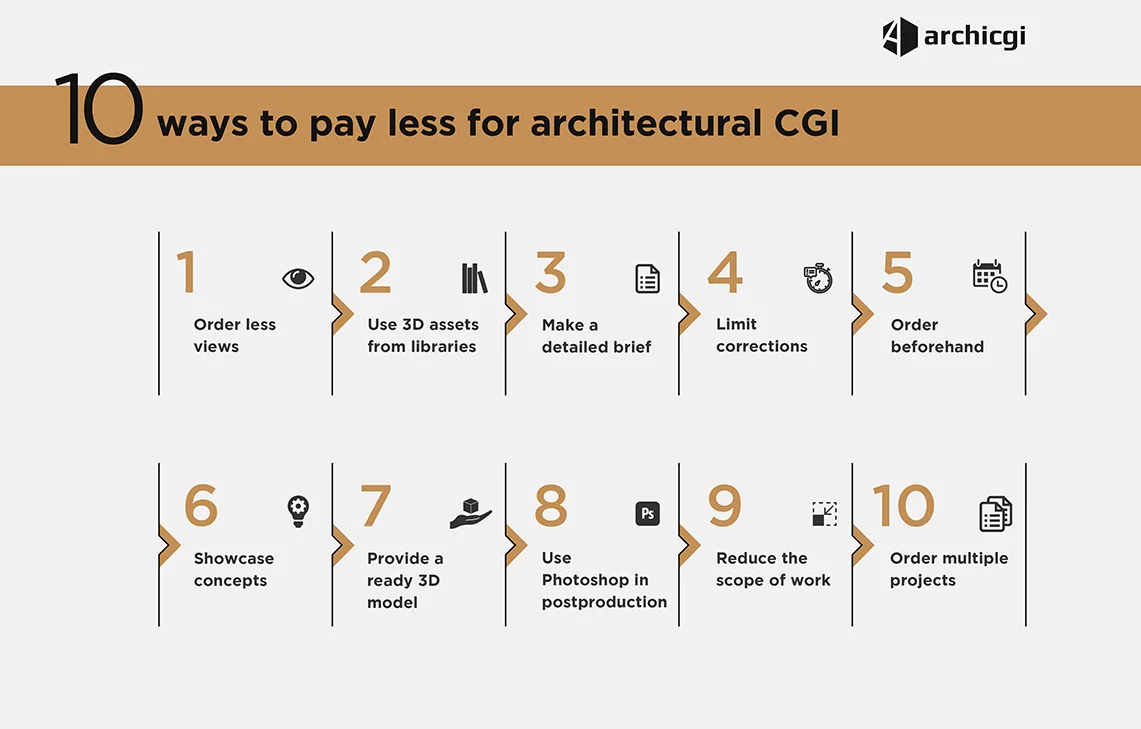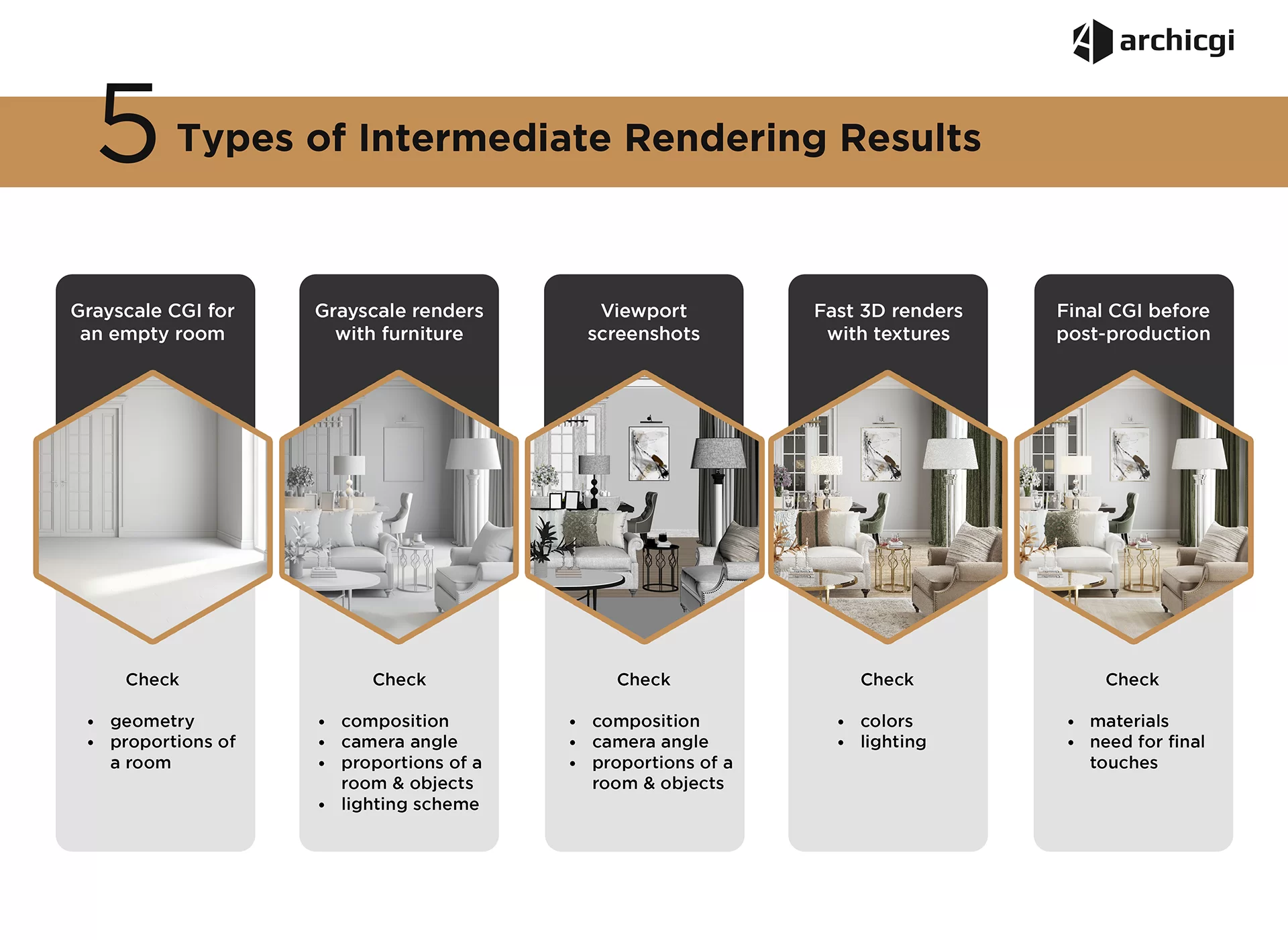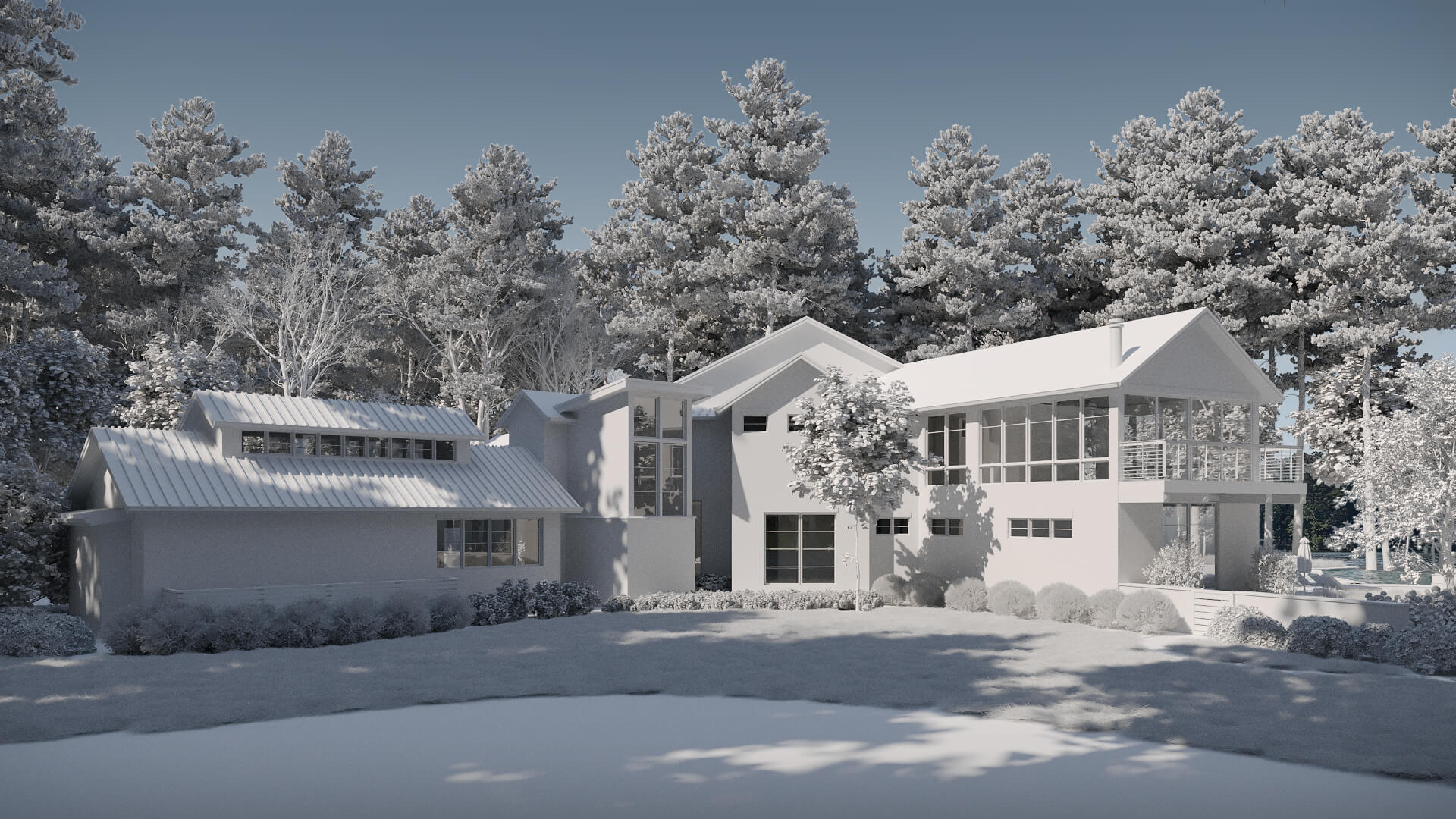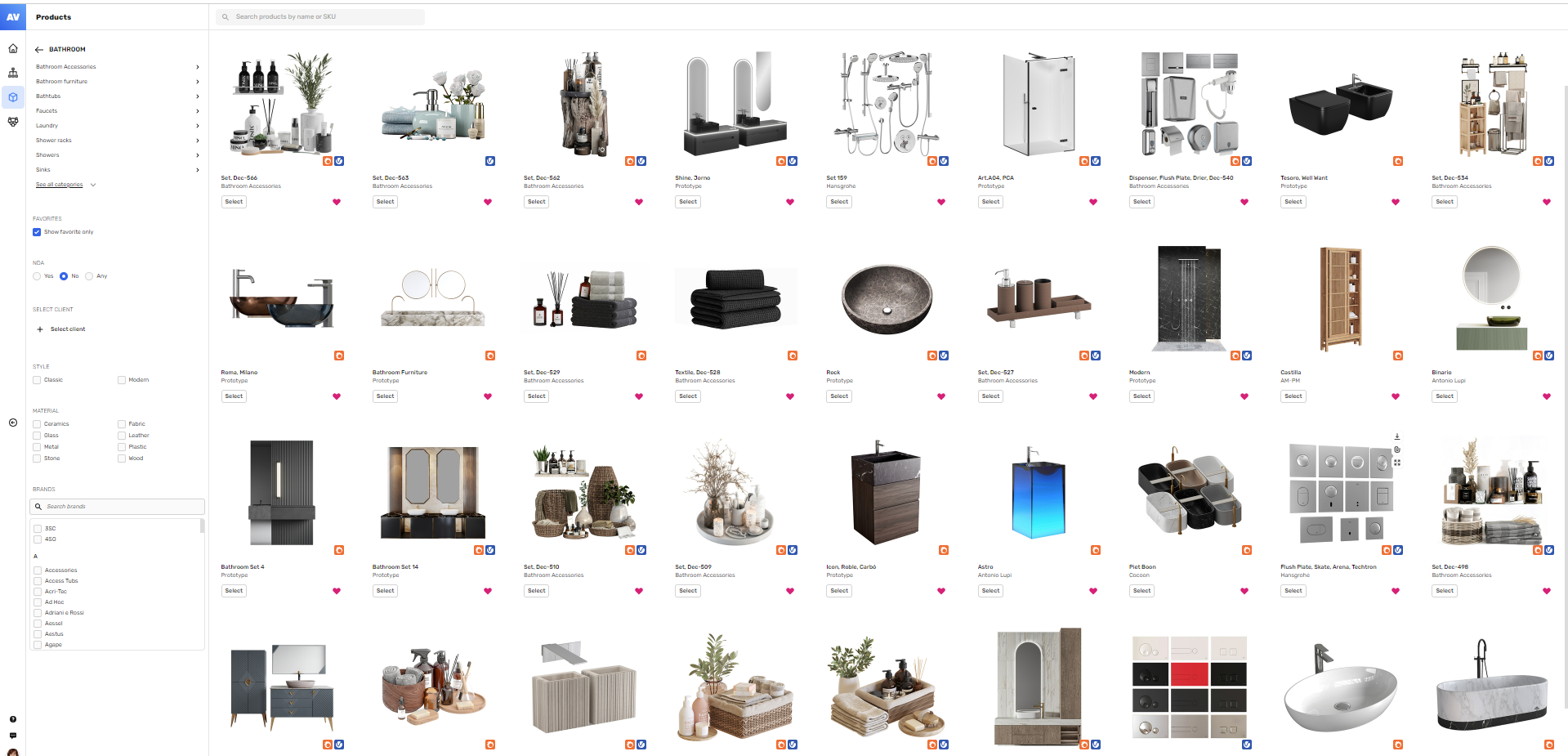The Cost of 3D Rendering
CHAPTER
09
The Cost of 3D Rendering
The crucial thing about 3d rendering pricing is to understand the most widespread strategies.
Architectural visualization studios usually adopt one of these four: pricing per view, hourly rate, service packages, and client-oriented approach. The latter includes creating special prices for a client based on the scale and frequency of orders. We use it for high-scale projects, as it allows us to find optimal solutions for all parties involved.
You can find out more about every strategy in our blog post about types of 3D rendering pricing.
#1. The Cost of Exterior Rendering
The price of exterior rendering primarily depends on the scale of the architectural project. Modeling low-rise, mid-rise, and high-rise buildings differ in terms of timing and workload. Simply put, 3D modeling for a small house will take considerably less time and therefore cost less.
Architectural style contributes to the price, too. A rococo palace is likely to need a united effort from a whole team of 3D visualizers. They will need to build and texture all the moldings, sophisticated ornaments, and details that will capture viewers’ hearts. A minimalist house facade with few materials and minimal architectural detailing will be done considerably faster and at a lower price.
Another major aspect influencing the price is the choice of background. The environment for the project can be constructed digitally or made from photos, usually drone shots. The second option is called photo matching. It works faster, delivers renderings that look extraordinary and comes at a better price.
Last but not least, adding elements such as people, cars, birds and animals, food, and flowers on the tables will add to the cost. The exact choice of objects depends on the concept and helps to infuse the exterior rendering with life.
Furthermore, the number of types of perspectives will definitely influence the final exterior rendering price. The exact amount will depend on the number of objects to be featured in the final output and their complexity.
#2. Interior 3D Rendering Price
The price of interior visualization is formed based on 10 factors. The first, most obvious one would be the resolution. Full HD is considered the default option. For a resolution higher than 1920 by 1080, the interior rendering price will increase. Other important factors are the style and layout of the space. Heavy ornaments, intricate moldings, abundant furniture and decor, and complex interior layout will add to the cost, too.
Another crucial factor influencing the interior rendering price is the need for creating custom textures and 3D models. Developing these will require time and considerable effort on the 3D modelers’ behalf and therefore should be included in the final price.
Workflow-wise, interior rendering price depends upon aspects such as the number and volume of corrections, the deadline, the scale of the order, and the quality of the 3D rendering brief.
You can learn how the factors above may impact your project in our blog post about the interior rendering cost. You will find there a simple yet comprehensive explanation for each aspect and find ways to use them to your advantage.
#3. The Cost of a Virtual Tour
The 3D Virtual tour price is calculated in a similar fashion to that of a still architectural rendering. One important difference, though, is that a 3D tour requires building, texturing, and rendering of the entire 3D scene, including every nook and cranny of the space. In contrast, in the case of a still 3D render, a 3D visualization artist may speed up the workflow by building only those parts of the virtual scene that will be featured in the rendering.
The main factors influencing the price are the complexity of the design project, the number of viewpoints, the need for custom modeling of interior and architectural elements, the project timing, and the number and scale of corrections made at revision rounds. You may find more information about how each of these factors works in our article about the price of virtual tours.
Just like with any 3D rendering products, there are ways and tactics for getting a 3D virtual tour on a budget. The first and most important step is to provide a detailed brief. The less guesswork and research the CGI team will make, the better a price you will get. The next thing is, of course, to avoid rush work. Start the project with enough time for the 3D artists to deliver results, and you will avoid being charged for urgency. You may find more secrets to minimizing the resulting price in our blog post about the 3D virtual tour cost.
#4. The Cost of Architectural Walkthrough
An architectural animation cost depends primarily on the scale of the object shown and the environment shown. Naturally, the taller the building, the more complex the structure and detailing, the higher the cost for architectural 3D modeling is.
A great way to reduce the cost of 3D modeling here is to provide 3D visualizers with a CAD model of the building. If the model is of sufficient quality to be improved upon and used in the architectural flythrough, it will reduce the cost drastically. If the quality is insufficient, it will still be useful to 3D artists as a reference.
The complexity and scale of the environment influence the cost, too. It can be modeled from scratch in photorealistic quality or created based on a drone-shot video. 3D Animation with drone footage is budget-friendlier, as the artists don’t need to build everything digitally.
Furthermore, the cost of a 3D walkthrough depends on its length, the complexity of camera movements, and the visual effects used. Hence the need to carefully choose the cameras and areas to show. The 3D artists will gladly help narrow down the selection without losing any information or visual impact.
Furthermore, the cost of a 3D walkthrough depends on its length, the complexity of camera movements, and the visual effects used. Hence a need to carefully choose the animation camera shots and areas to show. The 3D artists will gladly help narrow down the selection without losing any information or visual impact.
Atmosphere-wise, the price of an architectural animation also depends on the lighting, time of day, season, and weather chosen. Summer scenes, for instance, usually add less to the cost than winter ones. Moreover, getting a few scenes with seamless transitions from day to dawn and night is entirely possible, yet will come at a cost, too. The visual impact of transitions is show-stopping, through. Imagine showing your project in spring with flower petals gently falling from the blossoming trees and washed in golden sunlight. Then, the scene will move to the golden hues of the autumn, and next — to sparkling white snow, fluffy snowflakes, and Christmas lights seen through the windows.
The only thing that could make this 3D flythrough more atmospheric is music and a voice-over. These elements can totally be added to the CG video and of course, will have a certain impact on the cost. For instance, one can opt for a royalty-free soundtrack or get a unique piece of music.
In addition, the cost depends on post-production elements. For instance, we can add 3D people to the animation, as well as animals or cars. These characters are used to infuse the video with light, make it more dynamic, and appeal to viewers.
Just as importantly, one should remember about the revisions. Their number and amount may have a heavy impact on the final cost of an architectural animation. The wise strategy would be not to skip any workflow stages and see that everything aligns with your vision at every step of the way. Such an approach will reduce the number of revisions to a minimum and help keep the cost of architectural animation within budget.
How To Save Money On Any Kind of 3D Architectural Visualization

To save money on CGI rendering with no loss of quality, one needs to prepare a detailed technical assignment and provide enough references, such as technical drawings and material samples. This way, 3D artists will be able to implement the concept faster and with greater precision. Furthermore, placing a non-urgent order will give a studio more time to work on it and also decrease its cost.
Next, opting for simplified intermediate results helps to minimize the number of corrections in the final 3D model render. Because the more detailed an image is, the longer it will take to make changes in it. And the more time is required for corrections, the higher the cost will be.

This is why 3D architectural rendering studios offer to create grayscale 3D renders and fast renders, or so-called preliminary drafts. With those, architects can coordinate the production of visuals with 3D artists at different stages. If corrections are needed at a particular stage, they can be made quickly, at no extra cost.
Get your project estimated in just 1 hour - fill out this brief!
Main Types of Preliminary Results

- Grayscale 3D renders show ready interiors and exteriors with no textures or lighting applied. They allow architects to check the selected 3D models and the overall composition of a scene. In case there’s a need to change something, it can be done quickly and won’t reflect on the cost.
- Preliminary drafts go further, showing the lighting and textures that aren’t traced perfectly just yet. They make it possible for an architect to see the geometry of a place and to make corrections immediately if something doesn’t correspond to the technical assignment.
- And finally, a collection of furniture 3D models allows the designer to select the elements that will fill the room, instead of having everything modeled from scratch. Normally, this works perfectly for non-essential items, such as decorations and background fillers. Most importantly, it allows for streamlining the rendering process, making it times more cost-efficient.



Want to learn how much your project costs? See how we evaluate 3D rendering projects
See our pricing